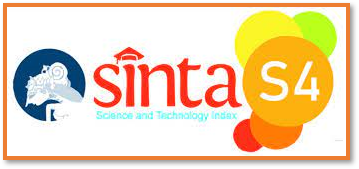Differences in Risk Factors between Simple Febrile Seizures and Complex Febrile Seizures
Abstract
Full Text:
PDFReferences
Eilbert W, Chan C. Febrile seizures: A review. 2022;3(4):1–6.
Smith DK, Sadler KP, Benedum M. Febrile Seizures: Risks, Evaluation, and Prognosis. 2019;99(7):445–50.
Shah PB, James S, Elayaraja S. EEG for children with complex febrile seizures. 2020;2020(4).
Sawires R, Buttery J, Fahey M. A Review of Febrile Seizures: Recent Advances in Understanding of Febrile Seizure Pathophysiology and Commonly Implicated Viral Triggers. 2022;9(January):1–8.
Leung, A. K. C., Hon, K. L., & Leung, T. N. H. (2018). Febrile seizures: An overview. Drugs in Context, 7, 1–12. https://doi.org/10.7573/dic.212536
Tang, J., Yan, W., Li, Y., Zhang, B., & Gu, Q. (2014). Relationship between common viral upper respiratory tract infections and febrile seizures in children from Suzhou, China. Journal of Child Neurology, 29(10), 1327–1332. https://doi.org/10.1177/0883073813515074
Kilic, B. (2019). Clinical Features and Evaluation in Terms of Prophylaxis of Patients with Febrile Seizures. SiSli Etfal Hastanesi Tip Bulteni / The Medical Bulletin of Sisli Hospital, 53(3), 276–283. https://doi.org/10.14744/semb.2019.30633
Kanta, S. I., Khan, N. Z., & Mahmud, K. S. (2022). Influence of Febrile Seizure in Children’s Neurodevelopment. Dhaka Shishu (Children) Hospital Journal, 37(1), 45–50. https://doi.org/10.3329/dshj.v37i1.59116
Dasmayanti, Y., Rinanda, T., Bakhtiar, Imran, & Anindar. (2015). Hubungan Kadar Hemoglobin dengan Kejang Demam Pada Anak Usia Balita. Sari Pediatri, 16(5), 351–355
Fuadi, F., Bahtera, T., & Wijayahadi, N. (2016). Faktor Risiko Bangkitan Kejang Demam pada Anak. Sari Pediatri, 12(3), 142. https://doi.org/10.14238/sp12.3.2010.142-9
Hajar, J. Z., Zulmansyah, Z., & Afgani, A. (2015). Universitas Islam Bandung Repository. Hubungan Karakteristik Pasien Dengan Kejadian Kejang Demam Anak Di Rumah Sakit Al-Ihsan.
Muenchhoff, M., & Goulder, P. J. (2014). Sex Differences in Pediatric Infectious Diseases. The Journal of Infectious Diseases, 120-126.
Gourabi H. Febrile seizure: demographic features and causative factors. Iranian J Child Neurol. 2012;6:33-7
Satyanegara. (2014). Ilmu Bedah Saraf. Jakarta: Gramedia Pustaka Utama
Ikatan Dokter Anak Indonesia. (2016). Rekomendasi Penatalaksanaan Kejang Demam. Unit Kerja Koordinasi Neurologi Ikatan Dokter Anak Indonesia, 1.
Mosili, P., Maikoo, S., Mabandla, M. V., & Qulu, L. (2020). The Pathogenesis of Fever-Induced Febrile Seizures and Its Current State. Neuroscience Insights, 15. https://doi.org/10.1177/2633105520956973
Mikati, M. A., & Rahi, A. C. (2005). Febrile seizures: From molecular biology to clinical practice. Neurosciences, 10(1), 14–22.
Chung, S. (2014). Febrile seizures. Korean Journal of Pediatrics, 57(9), 384–395. https://doi.org/10.3345/kjp.2014.57.9.384.
Gurnida, A Dida. 2011. Revolusi Kecerdasan Nutrisi Bagi Perkembangan Otak. Fakultas Kedokteran Universitas Padjajaran : Bandung
Angraini, D. I., & Ayu, P. R. (2014). The Relationship Between Nutritional Status and Immunonutrition Intake with Immunity Status. Jurnal Kedokteran Unila, 158-165.
Ahmed, S., Finkelstein, J. L., Stewart, A. M., Kenneth, J., Polhemus, M. E., Endy, T. P.,Mehta, S. (2014). Review Article: Micronutrients and Dengue. The American Society of Tropical Medicine and Hygiene, 1049-1056.
Guyton, A. C., & Hall, J. E. (2011). Textbook Medical of Physiology (12 ed.). Elsevier
Twistiandayani, R., & Wintari, H. R. (2017). Hubungan Kadar Hemoglobin dan Leukosit dengan Kejadian Febris (Demam) pada Anak Usia 6-12 Tahun. Jurnal Sains, 7(14), 37–42.
Rasyid, Z., Astuti, D. K., & Purba, C. V. G. (2019). Determinan Kejadian Kejang Demam pada Balita di Rumah Sakit Ibu dan Anak Budhi Mulia Pekanbaru. Jurnal Epidemiologi Kesehatan Indonesia, 3(1), 1–6. https://doi.org/10.7454/epidkes.v3i1.2108
Liu, Z., Li, X., Zhang, M., Huang, X., Bai, J., Pan, Z., Lin, X., Yu, D., Zeng, H., Wan, R., & Ye, X. (2018). The role of Mean Platelet Volume/platelet count Ratio and Neutrophil to Lymphocyte Ratio on the risk of Febrile Seizure. Scientific Reports, 8(1), 1–10. https://doi.org/10.1038/s41598-018-33373-3
Tang, L., & Chen, J. R. (2021). The predictive value of hemocytometry based on peripheral platelet-related parameters in identifying the causes of febrile seizures. Journal of Inflammation Research, 14, 5381–5392. https://doi.org/10.2147/JIR.S334165
Pisacane A, Sansone R, Impaglizzo N, Coppola A, Ronaldo P, D’Apuzzo A, et al. Iron deficiency anaemia and febrile convulsions: case-control study in children under 2 years. BMJ. 1996;313(7056):343.
Hidayati L, Hadi H, Lestariana W, Kumara A. Anemia dan prestasi belajar anak sekolah dasar. Jurnal Kesehatan Universitas Muhammadiyah Surakarta 2010;3:107
Meena J, Meena S, Sitaraman S. The correlation of iron status and first febrile seizure: a prospective case-control study. IOSR J Dent Med Sci 2016;15:42.
Johnston MV. Iron deficiency, febrile seizures and brain development. Indian Pediatrics 2012;49:13-4.
DOI: http://dx.doi.org/10.30872/j.kes.pasmi.kal.v6i1.9882
Refbacks
- There are currently no refbacks.
Indexing by :










